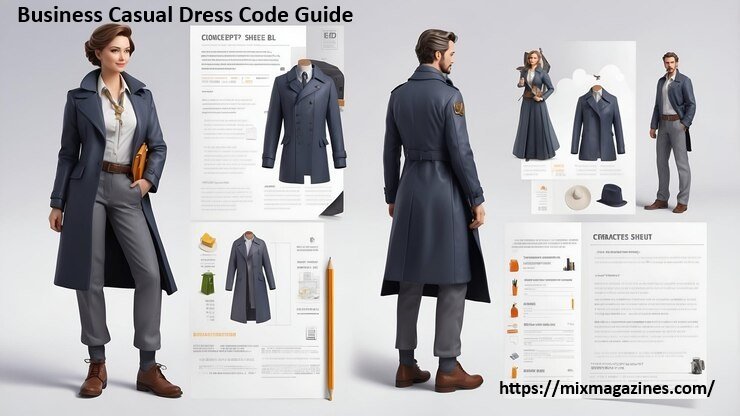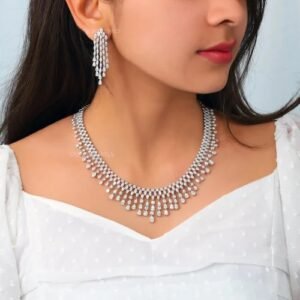
Business Casual Dress
Introduction
Navigating the world of business casual attire can be challenging, especially when dress codes vary widely between companies. Whether you’re starting a new job or looking to refresh your wardrobe, this guide will help you master the business casual dress code with confidence.
What is Business Casual?
Business casual dress code that blends professional and casual elements, offering flexibility while maintaining a polished appearance. Unlike formal business attire, Business Casual Dress allows for more comfort and personal expression, but it’s still important to adhere to professional standards.
Key Elements of Business Casual Attire
1. Tops: Shirts, Blouses, and Blazers
- For Men: Button-down shirts, polos, and sweaters are staples. Opt for solid colors or subtle patterns.
- For Women: Blouses, tailored tops, and blazers work well. You can experiment with soft patterns and colors, but avoid anything too flashy.
- Blazers: A well-fitted blazer can elevate any business casual outfit, making it more polished.
2. Bottoms: Pants, Skirts, and Dresses
- For Men: Chinos, khakis, and dress pants are ideal. Avoid jeans unless explicitly allowed.
- For Women: Pencil skirts, dress pants, and midi dresses are great options. Skirts and dresses should be of an appropriate length, typically knee-length or longer.
3. Footwear: Shoes that Complement Your Outfit
- For Men: Loafers, oxfords, and dress shoes are preferred. Sneakers are usually too casual unless specifically allowed.
- For Women: Flats, loafers, and low to medium heels work well. Avoid overly casual shoes like flip-flops or overly flashy heels.
4. Accessories: The Finishing Touches
- For Men: Keep accessories minimal with a nice watch, belt, and perhaps a tie if needed.
- For Women: Simple jewelry, a structured handbag, and a belt can complete the look. Avoid overly bold or distracting accessories.
Business Casual Do’s and Don’ts
Do’s:
- Keep it Professional: Even though the dress code is more relaxed, maintain a professional appearance.
- Prioritize Fit: Ensure that your clothes are well-fitted. Baggy or overly tight clothing can look unprofessional.
- Know Your Company Culture: Some companies have more relaxed standards, while others are more conservative. Adjust accordingly.
Don’ts:
- Avoid Casual Fabrics: Denim, jersey and overly casual materials can undermine a business casual look.
- Don’t Overdo Patterns: While subtle patterns are fine, avoid anything too bold or loud.
- Skip the Gym Wear: Leggings, hoodies, and athletic wear are not appropriate for business casual environments.
Business Casual for Different Seasons
Spring/Summer
- Lighter fabrics and colors work well during warmer months. Consider cotton, linen, and breathable materials.
- Opt for short-sleeve shirts or blouses, and dresses or skirts with appropriate lengths.
Fall/Winter
- Layering is key during colder months. Sweaters, cardigans, and blazers made of warmer fabrics like wool are excellent choices.
- Darker colors and heavier materials, such as tweed and flannel, are suitable for the season.
Business Casual on a Budget
Dressing business casual doesn’t have to be expensive. Here are some tips to build a versatile wardrobe without breaking the bank:
- Shop Sales and Discounts: Keep an eye out for sales at your favorite stores.
- Invest in Basics: Spend more on timeless pieces like blazers and dress pants, and save on trendier items.
- Mix and Match: A few key pieces can be mixed and matched to create multiple outfits.
Conclusion
Mastering the business casual dress code is all about balance. By combining comfort with professionalism, you can create a versatile wardrobe that works for any office setting. Remember to stay true to your style while respecting the guidelines of your workplace. With this guide, you’ll be well on your way to dressing confidently and appropriately in a Business Casual Dress environment.
FAQs: Business Casual Dress Code Guide.
1. What is considered Business Casual Dress attire?
- Answer: Business Casual Dress attire typically includes dress pants or chinos, a button-down shirt or blouse, and closed-toe shoes. Blazers and sweaters can also be part of a business casual wardrobe. It’s a balanced mix between formal business wear and more relaxed, casual clothing.
2. Can I wear jeans in a business casual setting?
- Answer: Jeans are generally not considered business casual unless specifically allowed by your company’s dress code. If jeans are permitted, opt for dark, well-fitted, and clean denim without any rips or distressing.
3. Are sneakers appropriate for business casual?
- Answer: Sneakers are usually too casual for a traditional business casual dress code. However, some modern workplaces may allow clean, minimalist sneakers. When in doubt, it’s best to choose more formal footwear like loafers or dress shoes.
4. How should I dress for a business casual job interview?
- Answer: For a business casual job interview, aim for a polished look. Men might wear dress pants with a button-down shirt and a blazer, while women could opt for a blouse paired with dress pants or a knee-length skirt. Closed-toe shoes are recommended for both men and women.
5. What’s the difference between business casual and smart casual?
- Answer: Business casual is more formal than smart casual. While both styles are relaxed, business casual leans towards more professional attire, like dress pants and blouses, whereas smart casual may include more relaxed pieces like well-fitted jeans or stylish sneakers.
6. Can women wear dresses in a business casual environment?
- Answer: Yes, women can wear dresses in a Business Casual Dress environment as long as the dress is appropriate in length (knee-length or longer) and style. Avoid overly casual or flashy designs, and consider pairing the dress with a blazer or cardigan for a more professional look.
7. What colors are appropriate for business casual?
- Answer: Neutral colors like black, navy, gray, and beige are always safe choices for Business Casual Dress attire. Soft colors like light blue, white, and pastels are also appropriate. While you can incorporate some patterns, it’s best to keep them subtle.
8. Is business casual the same across all industries?
- Answer: No, the interpretation of business casual can vary depending on the industry and company culture. For example, a tech company might have a more relaxed dress code compared to a law firm. Always consider the specific context of your workplace.
9. How can I transition from business casual to more formal attire if needed?
- Answer: To transition from business casual to formal attire, consider adding a tie, a more structured blazer, or swapping your chinos for dress pants. Women might switch to a more formal dress or add classic accessories like pearls or a structured handbag.
10. Can I wear a polo shirt as part of a business casual outfit?
- Answer: Yes, polo shirts can be appropriate in a Business Casual Dress setting, especially in less formal environments. Ensure the polo is clean, well-fitted, and in a solid color or subtle pattern.






